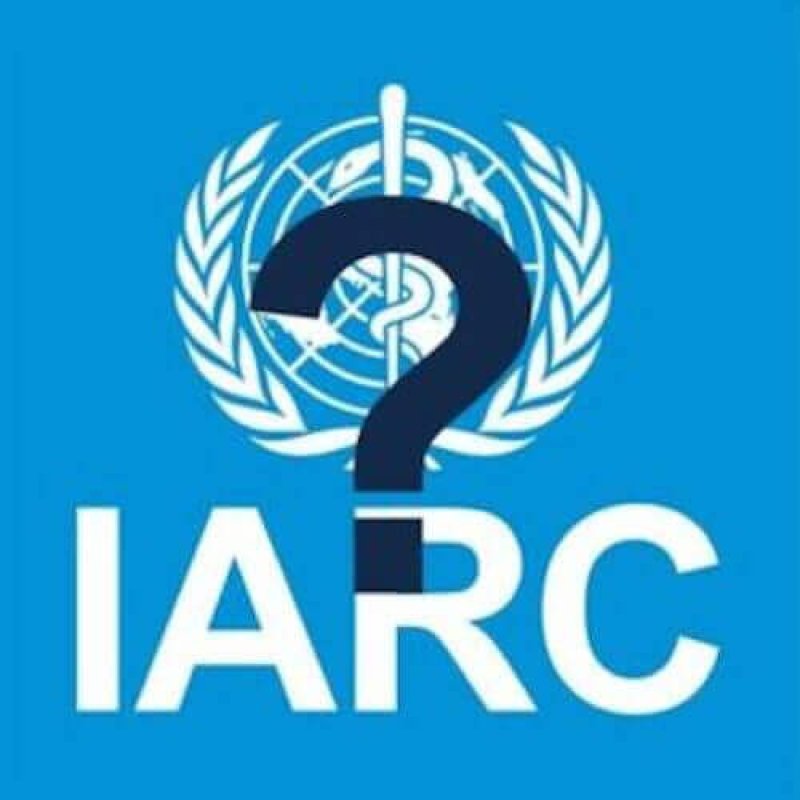- Scientists working with toxic tort law firms are compelling IARC to produce monographs for the purpose of increasing their lucrative opportunities as litigation consultants
- IARC officials are aware of this and complicit in the process
- Scientists openly declaring financial benefits from relationships with Predatort law firms are still allowed as full IARC monograph panel members
- Monograph 112 added glyphosate to the list of substances as a seemingly contrived after-thought. There is little doubt the same process of Predatort persuasion was applied for the glyphosate monograph as with benzene.
- IARC recently quietly updated several monograph publications to hide or change panel member conflict of interest information
- This WHO agency has been giving prejudicial preference to its “Good Old Boys” network (notably to the benefit of members of the Collegium Ramazzini) and relies on them to viscerally attack anyone who questions IARC.
Benzene is everywhere in modern Western life. When you fill up your car fuel tank, you inhale fumes containing traces of benzene. It is found off-gassing from petrochemicals in everyday plastics, rubbers and paints. Benzene is present in soaps, pharmaceuticals, cosmetics, clothing and furniture. Some claim it is detectable in electronic cigarettes. But our exposure levels are at such low doses (and getting lower) to the point that our precise detection devices are straining to find significant exposure data.
Benzene has been linked to various forms of cancer, but at what dose and for what period of time? It is estimated there may be up to 238,000 people in the US having contracted cancers potentially from benzene occupational exposure. Outside of direct occupational exposure, the public is not at all at risk from low-level contacts with benzene (and compared to other daily exposures to common carcinogens, such fear-mongering about benzene is ridiculous … thus many activists are doing so).
While it is nonsense to think the public should really be concerned, there are, however, a group of scientists (mostly statisticians and epidemiologists) who believe that any benzene exposure level, no matter how small, will cause cancer. They have made a good career out of lending their credibility to Predatort law firms seeking damages from benzene producers and users. These are the Benzene Bastards.
How to use a UN agency for personal profit
IARC, the International Agency for Research on Cancer, has produced three monographs declaring benzene a Group 1 carcinogen. This might seem like an excessive use of agency resources unless one considers the benefit IARC serves to US toxic tort litigators. SlimeGate is a series of articles (eventually a book) to show how these Predatorts need new scientific links to cancer exposures, how IARC has become central to their business model and how a group of scientists (tort-torts) in the IARC network have been influencing IARC and regulators on behalf of these Predatort law firms.
IARC’s monographs on benzene have been beneficial as evidence for toxic tort lawsuits. It is interesting to note that many of the law firms involved in this benzene bonanza had transitioned to this field once their asbestos honeypot dried up. The second IARC benzene report, however, failed to sufficiently link the substance to non-Hodgkin Lymphoma (NHL) and some tort-torts felt the hazardous exposure levels were set too high. As the Predatort law firms were lining up large numbers of NHL victims that could be linked to benzene exposure (who hasn’t at one time inhaled fumes from products containing benzene?), a link had to be determined. Solution: IARC needed to go back and produce a further benzene monograph (for the pleasure of the Predatorts) that clearly linked benzene to NHL.
Scientists like Bernard Goldstein, Peter Infante and Martyn T Smith have been lining their pockets as litigation consultants on benzene tort lawsuits for more than a decade. All three of them were involved in the 2009 IARC panel on benzene (Monograph 100F) and all of them have complained about the quality of IARC’s work on this monograph. Infante published a paper in 2010 demanding that IARC reconduct their 2009 benzene monograph (100F). Straif and others from IARC replied that they had confidence in the quality of their work and would not reconsider the research.
There was, in fact, a fourth tort-tort, Melvyn Kopstein, who was also trying to pad his personal pension by getting IARC to go back and re-open IARC’s benzene monograph to enable more lawsuits, but Straif rejected the idea point blank in 2015. Frustrated Kopstein went to the media to tell his story (not aware how much his being a greed-driven tort-tort was disgracing the scientific profession). While the Benzene Bastards agreed and sympathized with Kopstein’s arguments, they (and Straif) were not letting him into their sandbox. I suppose if you are not part of their Ramazzini circle, you could not be allowed to “share the wealth.”
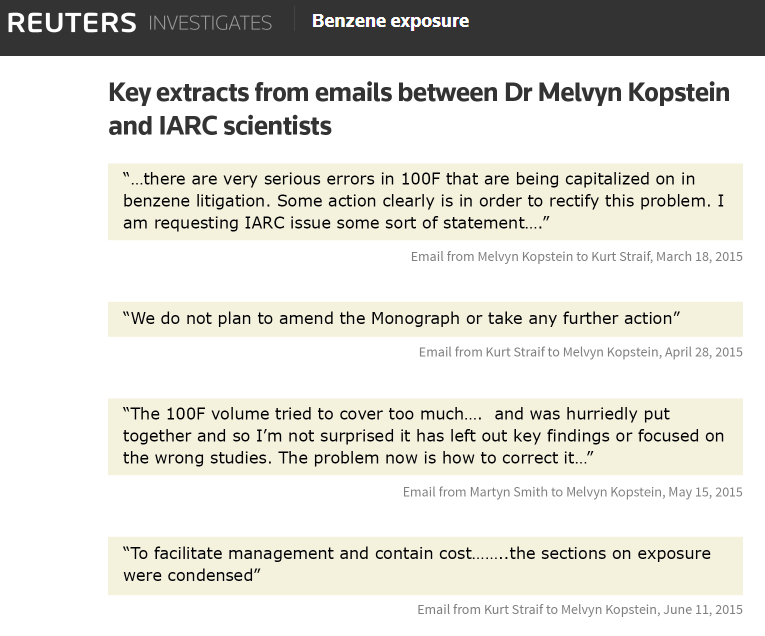
In an unsigned post, IARC strongly refuted the doubts raised on their process in the Reuters benzene article. They wanted everyone to go away.
Bending the IARC process
Kopstein was not representing the Predatort industry and he had no ties to IARC so he was easily ignored. But the argument still stood: a tighter benzene monograph would translate into better lawsuit payouts. The law firms left the task of generating a link between NHL and benzene to the three Benzene Bastards (but as cancer victims were being lined up for litigation, time was of the essence). So a year later, in 2016, the issue came up again.
This section is based on recent FOIAed documents that revealed some of the IARC actors’ conversations on the third benzene monograph decision.
Goldstein and Infante were tasked with pressuring the head of the IARC monograph program, Kurt Straif, to convene a third IARC panel on benzene, stating how this was essential as, without the totality of evidence linking benzene to non-Hodgkin Lymphoma (NHL), it would be “harder for plaintiffs to successfully sue industry.”
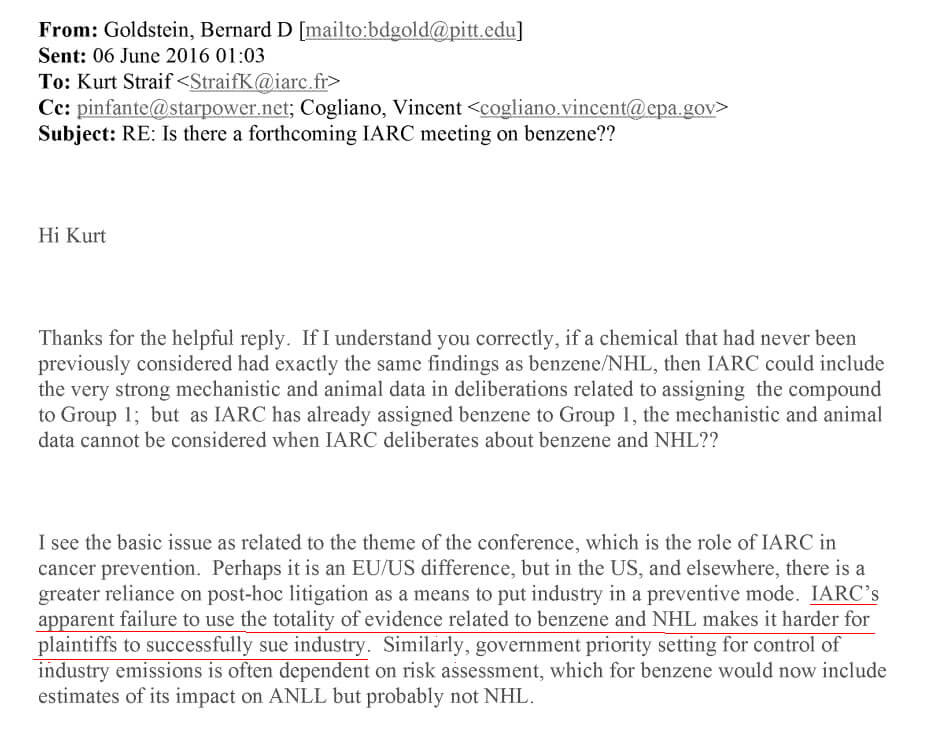
Did Goldstein feel that the role of IARC was to produce documents for the purpose of having endless litigation “put industry in a preventative mode.” Call me stupid, but I had always thought that was the role of the regulator to decide and not a group of scientists tied to law firms with a network in Lyon. In any case, the point was made clear to Kurt Straif. As the head of the IARC monograph program, he needed to call another monograph panel on benzene so the lawsuits could flow in the US and Bernie and Peter could profit as they “extract justice” from industry.
Goldstein’s crass email continues, where he schools Straif on regulatory processes and prevention philosophies:
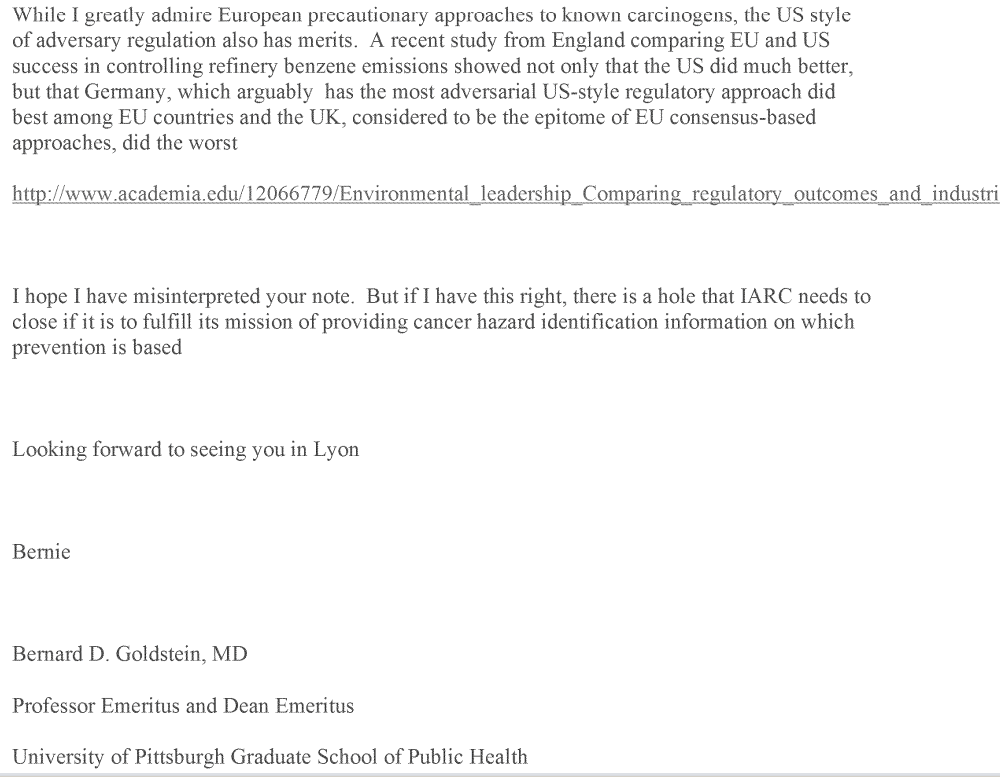
I could write a piece just on how wrong Goldstein is on risk and hazard, regulatory processes and prevention (I’ll save that for an SRA debate), but for the point of this article, it is clear how the motivation for a further benzene monograph was to help the Predatort law firms to sue industry on a greater scale. This message was sent to Straif in the tone of “calling in a favor.”
But Kurt Straif was having none of this. He knew the only purpose of an IARC benzene/NHL monograph was for the Predatort’s pleasure. Straif replied, once again as the year before (but more politely), that there was no intention to do a further monograph.
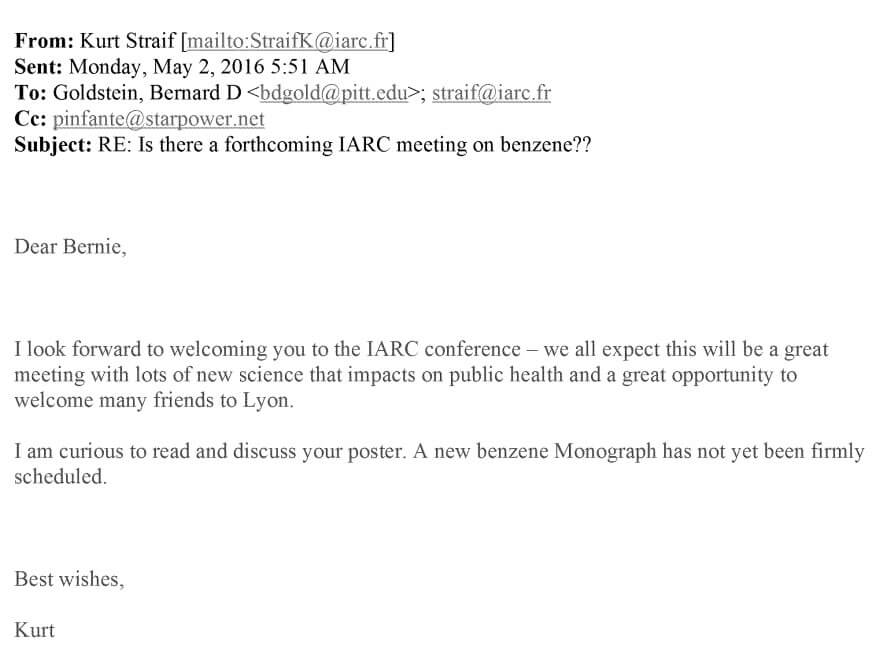
And besides, even if Kurt wanted to help his fellow Ramazzinis feed from the trough, he couldn’t. The head of the monograph programme had to respect proper internal IARC procedure. The 2014 IARC Advisory Committee Report (chaired by the ever neutral, impartial Chris Portier) did not recommend a further benzene monograph in its priorities for the coming five years, case closed. Given how much Straif has said in public about how much better IARC is than EFSA or the BfR in that they have rules and processes, it would be highly embarrassing for Kurt if he then flouted them to help out some friends in dire economic circumstances.
As IARC had no intention of doing a further monograph on benzene, the head of IARC’s monograph program, Kurt Straif, needed some “persuasion.” Goldstein and Infante prepared a poster on the links between NHL and benzene that they presented in front of 2000 scientists at the IARC 50th Anniversary conference in 2016 (Goldstein was even so arrogant as to dictate to IARC the timing of his presentation so as to fit his personal schedule). Straif was given the heads up how they were coming to Lyon to lobby hard for a further benzene monograph. Procedures can always change when opportunities are lucrative.
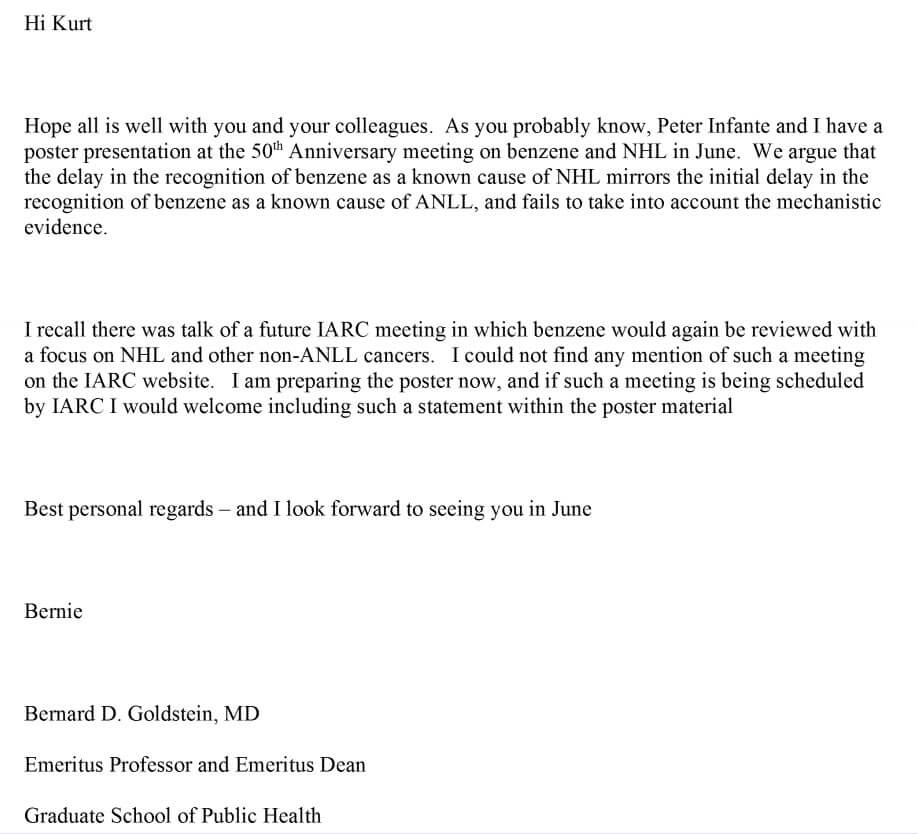
No scientific civil servant with any integrity would let himself be pushed around by self-serving, petty tort-torts hunting for consulting payouts … or maybe not. Maybe Kurt could be persuaded in person!
Five months later, in November 2016, IARC announces a monograph meeting on benzene … again. Ka-ching!
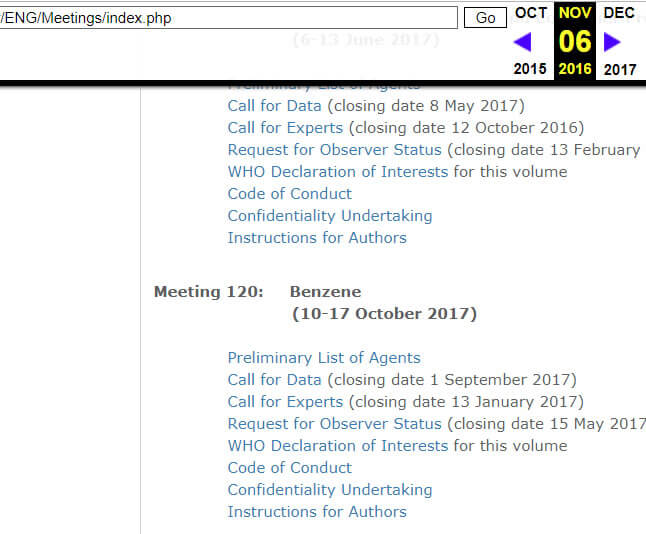
The third benzene monograph was published last December and it drew the connections to NHL needed to appeal to the Predatort pleasure for their slew of benzene/NHL lawsuits. Mission accomplished.
Maybe that is why Kurt Straif is no longer the head of the IARC monograph program as of … last December. The only thing unpleasant about this news is that Kate Guyton, the only person in IARC more cavalier with procedure and moral conduct than Straif, is now acting head of the monograph program. Curiously, as the Monograph group is composed exclusively of women, what does that now mean for the “Good Old Boys” network? Is this merely symbolic virtue signalling or does Elisabete have something in mind?
Why Kurt had to go
The head of the IARC monograph program relented to the pressure from the Benzene Bastards and, acting outside of normal agency protocol, rushed through a third monograph with no point or purpose but to help his friends identify more lucrative lawsuit opportunities to lend their expertise. This is a clear benefit for scientists within the IARC network who have been padding their pensions as tort-torts.
But that is only the first scandal.
The process for IARC’s monograph program is to provide studies based on the recommendations of the External Advisory Panel (the one Kurt got his friend Chris Portier to chair). There was no recommendation in 2015 for yet another monograph on benzene (I suspect Portier was only just learning about the types of revenue a tort-tort could make). Portier himself was co-chairing the IARC Monograph 100F panel (on benzene) so if there were a need for a further monograph, he most certainly would have seen to it when he produced the priorities report.
I contacted Kurt Straif in early autumn to get his response on the procedural oversight of holding a third monograph, but he passed my messages over in silence. I suspect I am like Voldemort (he whose name cannot be spoken) to these ridiculously impervious and unaccountable civil servants. Straif knew what was going on with the tort-tort bonanza and was party to it. The utter hypocrisy here is outrageous.
Worse yet on glyphosate, Straif used his position to further attack other agencies (who conducted proper risk assessments) suggesting even how it was worrying how these agencies were influenced by companies like Monsanto, all along while he knowingly fed the Predatort beast with lies and bad science. Good riddance!
But just when you think IARC could not fall deeper into the pit of disgrace, something else pops up to make even the most optimistic Risk-Monger shake his head.
Being a tort-tort is a conflict of interest
If you are paid $500 an hour to prepare and present depositions and testify in court as an expert witness for plaintiffs suing organizations for cancers they allegedly got from exposure to certain substances, and then you turn around and go to serve on an IARC panel that will produce a monograph which links that substance to the cancers you are getting paid for, it seems patently obvious you have a conflict of interest. You have, quite often, millions of dollars depending on “things going your way.”
A good example would be Martyn T Smith (who will also factor significantly in Part 3 of this chapter). At the time of the second IARC benzene monograph in 2009, Martyn had a pretty good side business going on. See a list of depositions below (a majority being benzene related) from his CV from that period and ask yourself whether he had time to do anything else. Depositions usually involve providing research documents and background information (much more if there is a Daubert hearing) and can take months. As Smith’s CV only mentioned two courses on toxicology at the time, perhaps Berkeley didn’t need him around too much.
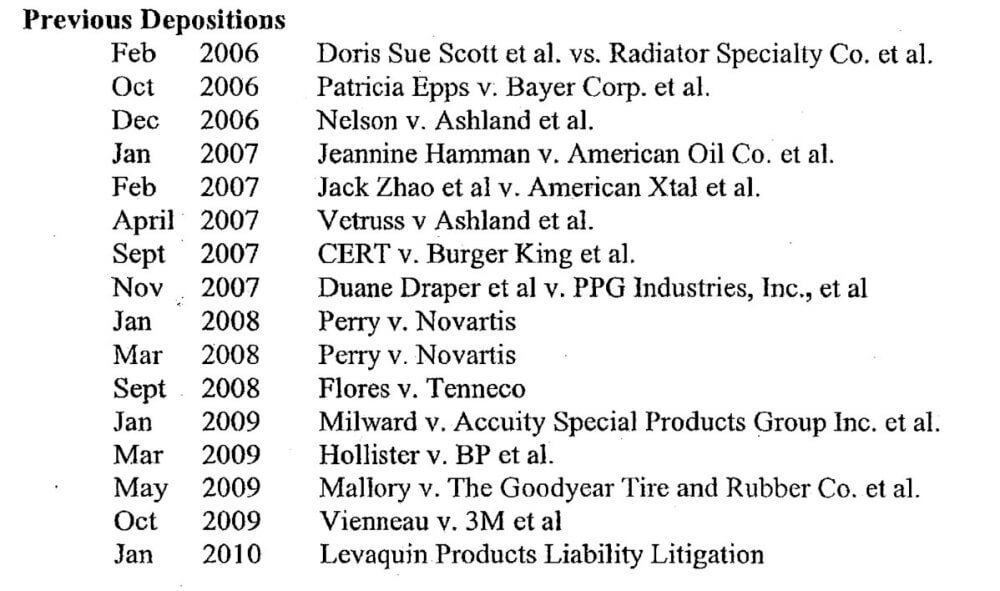
With this much personal investment in the litigation process, Martyn T Smith would stand to do even better if IARC were to reinforce its benzene cancer assessment.
It is quite possible many tort-torts have a “righteous predisposition.” Some believe they are serving humanity by helping victims receive settlements. There is a strong anti-industry bias in the epidemiology community so I can assume many tort-torts have found religion and see themselves as “angels” delivering justice. That they profit handsomely is merely “generous alms for the crusaders.”
Here is an example of one time-sheet for the preparation and drafting of a single expert report (filed by Chris Portier to Weitz & Luxenberg from his glyphosate deposition).
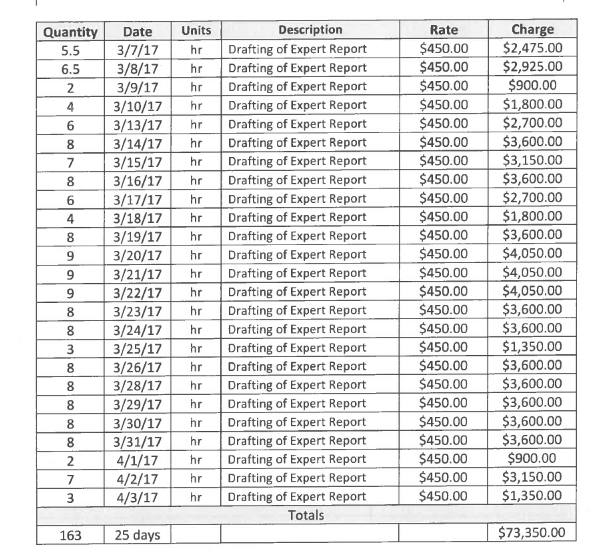
Multiply this amount by 16 in Smith’s case and you can get an idea of some baseline figures before the tort-tort even shows up in court or at a deposition. Righteous predisposition? Sorry Martyn, I’m looking at these numbers and I see it another way.

Smith and Bernie Goldstein had the audacity to participate on the second IARC panel in 2009 at the same time as they were consulting for law firms suing benzene manufactures (at least Infante recognized the conflict and only attended as an observer). More audacious is how Smith admitted he had been taking money from both the defense and the plaintiffs in benzene lawsuits.
How could neither of these tort-torts not recognize that receiving hundreds of thousands of dollars per case to depose and testify that benzene is a carcinogen was considered a conflict of interest in determining whether the substance is, indeed, a carcinogen? Worse, how could IARC have not only accepted these two on the panel, in full disclosure, but even proudly announce it (see Lancet Oncology publication)?
On its own, this flagrant misuse of conflict of interest rules with Goldstein’s and Smith’s involvement demonstrates how loathsome and cavalier the IARC monograph program and its officials can be regarding rules, methodology and ethical principles (especially when it comes down to helping out with financial opportunities for some of their “Good Old Boys”). Keep in mind this conflict of interest is nothing compared to the moral repugnance of forcing IARC to hold a week-long monograph meeting to improve their consulting opportunities with the law firms they are contractually tied to.
But it gets worse.
Disappearing conflicts of interest
Is it correct for a WHO agency like IARC to publish a monograph and then secretly go about changing the document? This was the subject of a Reuters special report which IARC vehemently denied. That denial is understandable as rewriting content in a published monograph would suggest IARC does not respect basic rules of scientific integrity.
What is once again indicative of the lack of scientific integrity at IARC (which has sadly become worse since Elisabete Weiderpass was announced as the new head), IARC discovered (probably only recently) that it was not acceptable to have actively consulting tort-torts serving as full members on IARC panels. So the WHO agency in Lyon quietly edited Martyn T Smith’s conflict of interest declaration out of its Monograph 100F page. In the updated Monograph 100F page on benzene, Martyn is no longer declared as actively consulting for Predatort lawsuits on benzene. But they could not get the Lancet Oncology to bend basic scientific ethical rules and rewrite a science publication.
See the updated IARC page on the benzene panel participants.
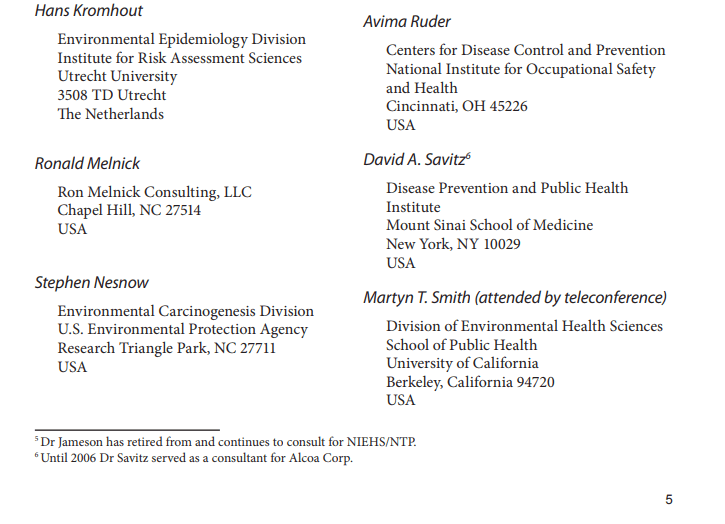
Smith’s conflict of interest seems to have fallen off of the page. Why is this? Perhaps Smith demanded that IARC remove his declaration. Frankly, if you are a highly-paid expert witness testifying for both sides of a lawsuit, this suggests you are slimier than the average tort-tort and I could understand why you would like to hide such despicable behavior.
RM note: This is indicative of how scandal-hardened these IARC officials have become. Last year I had exposed their post-publication editing of the IARC Advisory Group Priorities Recommendations report to pretend that Christopher Portier had declared his interest as an employee of the Environmental Defense Fund at the panel meeting (when in fact he did not). I used Wayback Machine to show this (see image below). This time the IARC web team removed any crumbs that could show the page updates and history on web archive sites like Wayback Machine. This is a smart way to hide improper actions but in the website address, the geniuses left the update information with: page upload as 062018.
It’s clear IARC are ethically challenged in quietly editing published documents.
It’s clear they were trying to not get caught.
It’s clear they were not very good at it.
… And IARC loves to boast how transparent they are. Pity.
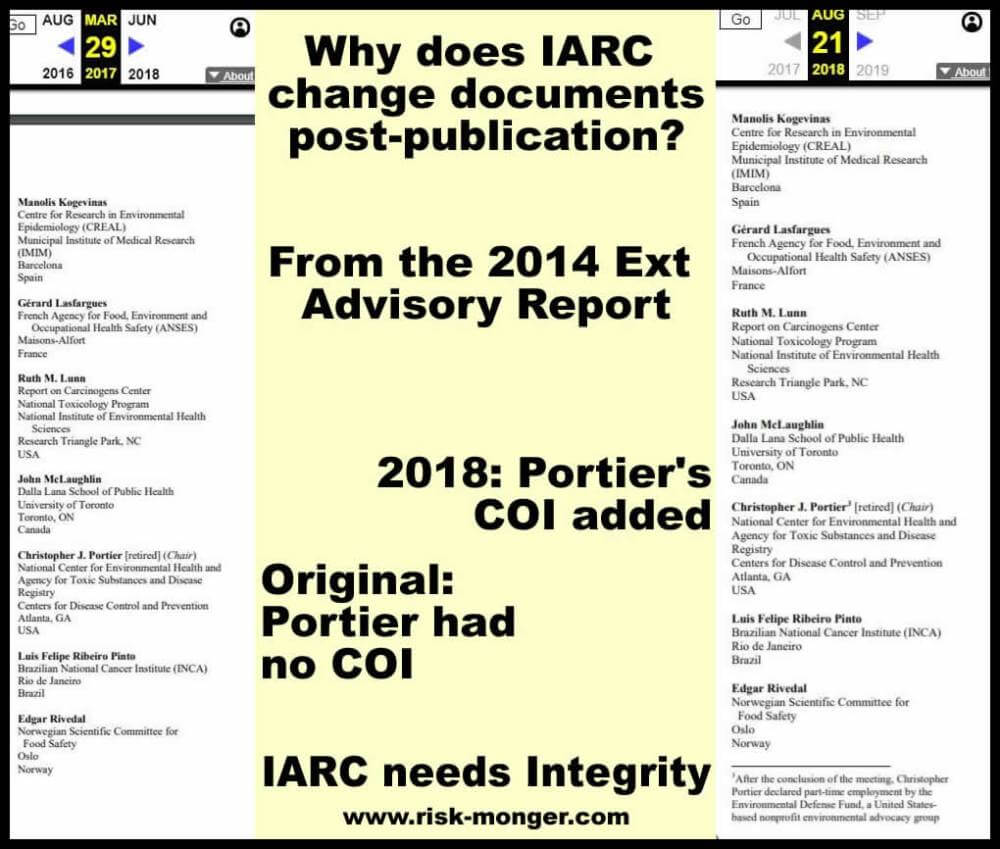
In quietly changing their monographs post-publication, IARC is behaving like a guilty party trying to cover up its transgressions. But this WHO agency comes across like the little boy with his hand caught in the cookie jar (and quick to lash out at anyone who notices). When will IARC learn to be responsible, honest and, well, mature?
The same predatort playbook for glyphosate?
As many would give a big “So what!” about benzene (it’s not in my Cheerios or wine and I don’t work with it), keep in mind how this serves as a backstory for the atrocious disregard for process and scientific integrity that is endemic inside IARC and their network of “Good Old Boys.” Could tort-torts have put the same influence as benzene on IARC in a bid to include glyphosate as soon as possible in a monograph given the Predatort strategy to make glyphosate into the next tobacco or asbestos?
The first point to consider was the skittishness of Kate Guyton’s message to all American members of the glyphosate monograph telling them to not respond to freedom of information requests. This flew in the face of US codes of conduct for academic accountability and made minced meat out of IARC’s pathetic claim of being transparent. What was Guyton trying to hide? They have been hiding information for four years … Kate must be morally exhausted.
Even without a similar tort-tort email chain, the situation with glyphosate screams malpractice and collusion. Glyphosate was never in the original list of substances for Monograph 112. The IARC meetings web page was only updated three times in 2014, in April, July and October. Meeting 112 was first announced on 16 July 2014 and it was only for “Some Organophosphate Insecticides.” As an aside, it should be noted they sent out a call for experts in the summer with a deadline of two weeks for interested parties to apply. This implies IARC had already selected the “Good Old Boys” they wanted in the room (this agency is simply wretched to the core).
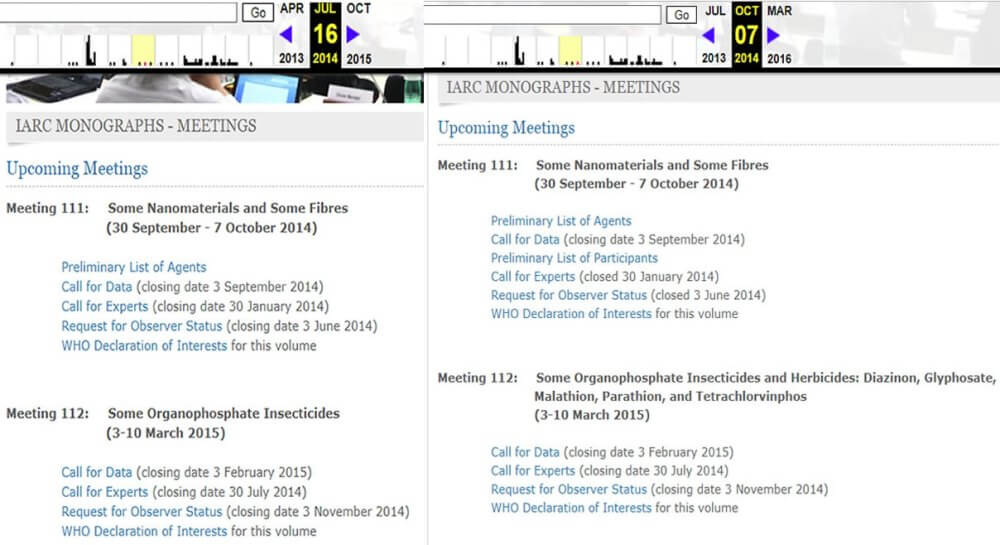
The next time the web page was updated was on 7 October 2014 (less than five months before the meeting). Only then was glyphosate announced as a substance for the panel. Glyphosate is not an organophosphate insecticide and it had absolutely no business being included in this meeting on insecticides (worse, after the call for experts period had closed). Why was glyphosate added so late in the process to a list of unrelated substances? Or should we ask: Which tort-tort scientist(s) was lobbying IARC to slip the herbicide into the group on behalf of Predatorts lining up a lawsuit action plan?
We know that Chris Portier had meetings with Lundy and Lundy in the month prior to the IARC glyphosate panel meeting … allegedly for a contract related to cancers arising from mobile phone use (another tort-tort wet dream). It would, of course, be pure coincidence that a mere ten days after the end of the panel meeting declaring glyphosate a probable carcinogen (the first such agency to ever conclude that) that a contract was inked up and waiting for Portier to sign. Sure, I’ll buy that.
It should not be overlooked that of the American members of the IARC Monograph 112 panel, a good number of them have since been receiving fees as expert witnesses (“bought and paid for” tort-torts). This includes the chair, Aaron Blair, Christopher Portier, Charles Jameson and Matthew Ross. These canaries certainly won’t sing and share their emails. Of course there is a much greater cabal of tort-torts feeding off of the 9000+ lawsuits on glyphosate but these are just the four arriving in Lyon with pension augmentation on their minds. The sound of people humming around the IARC coffee machine in March 2015 must have been quite a sight.
So while everyone is keeping quiet and IARC refuses to be transparent, the evidence seems to point to a strong likelihood that a similar Predatort influence strategy drove IARC towards including glyphosate in a completely different set of substances and delivering the goods the tort-torts needed to bring back to their law firms. Monsanto gets sued, farmers get screwed. Nothing in the behavior of IARC or its “Good Old Boy” network of tort-torts would convince me otherwise. The Benzene Bastard backstory is useful to understand how IARC operates (and for whom).
Will anyone answer my questions?
Contrary to what my trolls say, The Risk-Monger is concerned by the many forces threatening trust in science and the scientific method. SlimeGate is a series of case studies on how less than honest lawyers are using scientists to enrich themselves. I also feel IARC has badly lost its way on so many levels and has become a threat to the reputation of science and policy. I would like to contribute to the debate on reforming the agency but they do not communicate with me (on the day Elisabete Weiderpass was announced as director, I was even blocked on the IARC twitter page). So in absence of dialogue, and a further circling of the wagons, can anyone answer some of my questions.
– Why was a third IARC monograph linking benzene to NHL essential to the tort-tort litigation strategy if there were enough studies published (as they had said)?
– Why is IARC the only “go-to source” for Predatorts seeking new cancer causalities?
– As Straif knew of the tort-tort motivation and the number of benzene lawsuits depending on IARC determining a link between NHL and low-level benzene exposure, shouldn’t he have resisted simply out of principle?
– Did Straif’s decision to relent to Goldstein’s and Infante’s pressure for a further monograph go against IARC internal policy (of respecting the external panel’s priorities)?
– All of these actors, including Straif, are members of the Collegium Ramazzini. Did the Collegium, a sort of Rotary Club for activist scientists, provide the setting for their strategy?
– Did IARC secretly change their monographs when someone noticed their COI “Oopsie”?
– Was there a similar type of pressure put on IARC by Predatorts salivating over the potential litigation fee harvest from suing Monsanto over glyphosate?
– Isn’t it time for the scientific community to start cleaning up this slime?
Why are so few journalists looking at this scandal? Are they too afraid to go against the anti-corporate societal narrative? Are they too lazy or underpaid to do any deep-dive research? A sad testimony is I have had this freely available document for eight months (I have been quite sick for a good part of this time) and I never once feared that some journalist was going to beat me to the “news.” The research journalism profession is dead.
- Given that IARC is not transparent in releasing documents or discussions related to its monograph production;
- given that law firms do not disclose their correspondence or payments to their scientific tort-torts or NGOs;
- given that the media is not interested in reporting on the lamentable behavior of these Benzene Bastards …
… we can only conclude one point: as despicable as these little research recidivists are, they will continue to operate with impunity and continue to disgrace the reputation of the institution they pretend to represent (… and once again, I’ll probably suffer personally for showing this scandalously unethical behavior).
But whatever happens, IARC’s depravity never ceases to astonish me. You could just imagine my surprise to have read a rather spirited defense of IARC by none other than … Peter Infante. What a terrible postscript to a terrible story.
Postscript: An infante terrible
Peter Infante does not work as a scientist but as a litigation consultant on benzene. He attended the last two IARC benzene monographs as an observer (a position usually reserved for people with conflicts of interest like industry actors or governments who will be affected by the consequences of IARC monograph conclusions). He openly declared his interest: representing Predatorts for benzene lawsuits. That is fine. He is able to invoice a high rate for services delivered to satisfied clients (law firms) who make hundreds of millions from lawsuits based on questionable science and he is surely living a good life for services rendered in this toxic tort strategy. I should be happy for him and his very good fortune.
But when he pretends his consulting fees to Predatorts is science, this sliming needs to be evaluated in a proper light. Worse, when he fabricates personal attacks on credible and established scientists or journalists to protect his little financial honeypot and worse yet, when he then accuses them of being in the pay of his adversaries, Infante has crossed so many boundaries of human decency that the word “hypocrite” is far too kind to describe the abhorrent behavior of this petty tort-tort.
Infante wrote a scathing article against anyone who would dare question the pronouncements of IARC and the value it provides to scientists like, well, himself. The title said it all: “IARC Monographs Program and public health under siege by corporate interests.” Infante reinforced the “Monsanto bought the world” conspiracy theory, even referencing sources and documents from activists in US Right to Know and Corporate Europe Observatory (I wish I were making this up)! It was co-authored by other IARC Good Old Boys, litigation consultants and Ramazzini “keepers of the code” including: James Huff, Ronald Melnick and Harri Vainio, former IARC manager now serving as a toxicologist at the Kuwait University (also the better half of Elisabete Weiderpass, IARC’s new head who seemingly stopped using her hyphenated married name when her star started rising within IARC … Ouch)!
The commentary piece was stunning in its visceral and indignant attacks accusing, for example, distinguished scientists like Robert Tarone of being in the pocket of Monsanto (Tarone wrote a convincing article against the IARC Monograph 112 on glyphosate). Then, Infante took aim at the award-winning Reuters journalist, Kate Kelland, claiming she was a Monsanto mouthpiece. At one point, the commentary rifled off a series of references referring to all of them as funded or influenced by, yes, Monsanto. These apparently derogatory claims were made without any evidence but made to sting and slander anyone who would dare question IARC’s legitimacy. Robert Tarone wrote a measured reply to Infante’s rage, reminding him of some basic rules of scientific integrity.
It is incumbent upon the defenders of IARC to address the highly questionable and selective summary of glyphosate rodent studies forthrightly, rather than to question the motivation of critics of the IARC glyphosate classification and to continue to argue from authority that IARC Monograph procedures are beyond reproach.
I have never seen IARC engage in scientific discussions post-publication (they, rather, assume an “arrogance of infallibility”) and frankly I feel the present cabal in Lyon is incapable of such a basic scientific responsibility.
Infante was, in ice hockey terms, playing the role of IARC’s “enforcer,” ready to beat up and discredit anyone who was a threat. The gloves were off but who was giving the marching orders? It is curious that while Infante gave no proof to his claims on Kate Kelland, about a year after his outburst, it was revealed that an email between a Monsanto manager and the Reuters journalist was sealed in court. Were lawyers suing Monsanto leaking confidential documents to Infante for his article? Was that illegal (I’m sure Peter can find a good lawyer to protect him on that one)?
So how much was this “Infante terrible” profiting from IARC and the Predatorts. Well, according to a well-researched analysis by Nathan Schachtman, Peter Infante’s name has come up as a litigation consultant in at least 141 toxic tort cases, all on the plaintiff’s side. A back-of-the-envelope calculation would suggest Peter Infante has earned at least three million USD as a tort-tort consultant (a week socializing in Lyon as an observer to the benzene panel could easily fill his tort-tort time-sheet to the tune of around $50,000 … not counting possible double or triple billing of different law firms).
Money aside, should Infante be the best choice to question the quality of other scientists? In another article by Nathan Schachtman, it is obvious Peter’s scientific skills were not the finest. In the “Burst” benzene case, Infante “ransacked the catalog of expert witness errors.” The judge highlighted how Infante committed 12 basic scientific transgressions from cherry-picking to manipulating data to relying on irrelevant studies. To his defense, Infante claimed he was using IARC methodology … enough said.
So Infante writes an article attacking anyone who threatens his little business empire by accusing them of being in the pocket of … business (of being paid off by an organization only interested in money). Really now! As any epidemiologist worth his salt would attest, evidence matters. There was no evidence to back up Infante’s charges but this little scoundrel’s own closet was so full of damning skeletons. What a hypocrite!
This stinks!
Benzene has had, and will continue to have, a long rich history for Predatorts looking to link people with cancer to their large representation fees. And where this slime exists, it will attract tort-torts with the moral fiber like Peter Infante, Bernard Goldstein and Martyn T Smith. In enriching themselves, these Benzene Bastards will continue to diminish the credibility of science and the reputation of agencies like IARC, a shambolic organization quite ready to tarnish itself in the service of its network of Good Old Boys.
As for IARC, the agency is like a stinky room. The moment people enter, they think: “Gosh, there is a smell here.” After a bit of time, it becomes evident the smell is quite strong and unpleasant. At a certain point it overpowers as people then come to the realization there is no means to clear the air. Looking for the source of the stink, it becomes clear the entire room stinks. … Around 15 months ago, my opinion on IARC was sought by different industry actors in Washington. I advised that the US should stay a member and try to reform the agency from within. I thought the stink could be removed from the room. Weiderpass’ performance since she was chosen to lead IARC has shown that the stink wafting throughout the organization is permanent. It is now evident the only solution is to leave the room.
David Zaruk has been an EU risk and science communications specialist since 2000, active in EU policy events from REACH and SCALE to the Pesticides Directive, from Science in Society questions to the use of the Precautionary Principle. Follow him on Twitter @zaruk
This piece originally ran at the Risk Monger as SlimeGate 3/7: The Tort-Tort Scam 2/4: The Benzene Bastards and has been republished here with permission.

